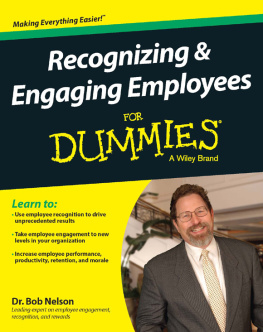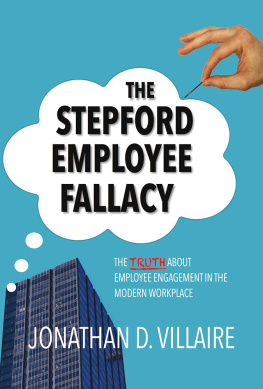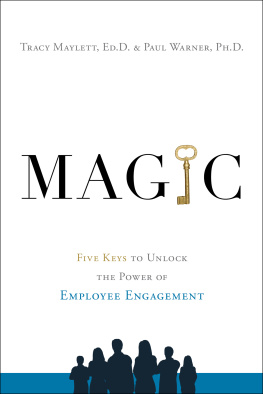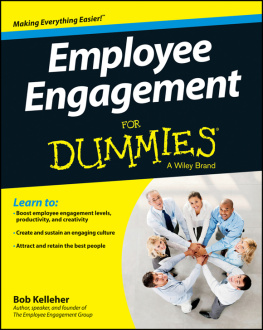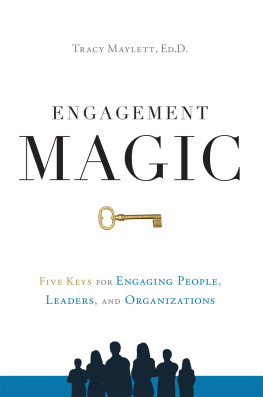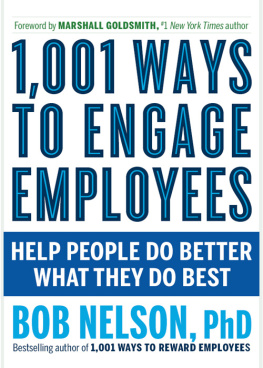The Enemy of Engagement
The Enemy of Engagement
Put an End to Workplace Frustrationand Get the Most from Your Employees
Mark Royal and Tom Agnew

Bulk discounts available. For details visit:
www.amacombooks.org/go/specialsales
Or contact special sales:
Phone: 800-250-5308
E-mail: specialsls@amanet.org
View all the AMACOM titles at: www.amacombooks.org
This publication is designed to provide accurate and authoritative information in regard to the subject matter covered. It is sold with the understanding that the publisher is not engaged in rendering legal, accounting, or other professional service. If legal advice or other expert assistance is required, the services of a competent professional person should be sought.
Library of Congress Cataloging-in-Publication Data
Royal, Mark, 1967
The enemy of engagement : put an end to workplace frustrationand get the most from your employees / Mark Royal and Tom Agnew.
p. cm.
Includes index.
ISBN-13: 978-0-8144-1795-9 (hbk.)
ISBN-10: 0-8144-1795-7 (hbk.)
1. Employee motivation. 2. Job satisfaction. 3. Performance. 4. Organizational effectiveness. 5. Management. I. Agnew, Thomas George Arnold. II. Title.
HF5549.5.M63R69 2012
658.314dc23
2011017499
2012 Hay Group, Inc.
All rights reserved.
Printed in the United States of America.
This publication may not be reproduced, stored in a retrieval system, or transmitted in whole or in part, in any form or by any means, electronic, mechanical, photocopying, recording, or otherwise, without the prior written permission of AMACOM, a division of American Management Association, 1601 Broadway, New York, NY 10019.
About AMA
American Management Association ( www.amanet.org ) is a world leader in talent development, advancing the skills of individuals to drive business success. Our mission is to support the goals of individuals and organizations through a complete range of products and services, including classroom and virtual seminars, webcasts, webinars, podcasts, conferences, corporate and government solutions, business books, and research. AMAs approach to improving performance combines experiential learninglearning through doingwith opportunities for ongoing professional growth at every step of ones career journey.
Printing number
10 9 8 7 6 5 4 3 2 1
Contents
C HAPTER 1
Theres Something Happening Here
C HAPTER 2
Frustration: The Silent Killer
C HAPTER 3
Workplace Frustration Spreads at Bernette
C HAPTER 4
Enabling High Levels of Performance from Engaged Employees
C HAPTER 5
Doing More with Less
C HAPTER 6
Engagement Walks in the Door and Trips over Enablement
C HAPTER 7
Charting the Way Back on Track
C HAPTER 8
Understanding Enablement
C HAPTER 9
Tackling Bernettes Enablement Issues
C HAPTER 10
Diagnosis and Prescription
C HAPTER 11
Starting to Get Results
C HAPTER 12
Managers as Agents of Organizational Change
Acknowledgments
F ROM THE TIME we began this process seven years ago, we have benefited from our clients desire to learn more about their organizations. We are grateful for their willingness to partner with us to explore the ideas presented in this book when few other organizations or consulting firms were focused on workplace frustration and employee enablement. While it would be impossible to acknowledge them all here, we offer special thanks to Karin Mayhew of Health Net, Inc., Gary Short of Kimberly-Clark, Rachel Levy of Daiichi Sankyo, and Steve Denault of COUNTRY Financial, who have been particularly generous in sharing with different audiences their experiences in monitoring and managing these issues.
Our colleagues within Hay Group Insight, Hay Groups employee research division, have also provided important input and guidance. We thank Will Werhane, our Global Managing Director, and members of our Global Management Team, including Ben Hubbard, Michele Goldberg, Mikito Ichikawa, and Andy Tunnard, for their support for our research program in general and this project specifically. The work of our Advanced Research Services group, Rebecca Masson, Juran Hulin, and Kerry-Ann McKnight, was critical in developing, refining, and validating the research behind the ideas presented in this book.
Additionally, we would like to express our appreciation for the contributions of a number of other Hay Group colleagues: Tom McMullen, Rick Lash, and Brian Langham for providing thoughtful and helpful feedback on drafts of the manuscript; Stephen Welch for perspectives on employee engagement and employee enablement in the communications, media, and technology sector; Bibi Hahn, Timis Rallis, Katie Lemaire, Jean-Marc Laouchez, Brian Langham, and Andreas Raharso for perspectives on strategic performance management; Mitch Kent for connecting us with AMACOM and Louis Greenstein; and Nick Boulter, Mary Fontaine, and David Harkleroad for their sponsorship of this effort.
Louis Greenstein and Tina Waters deserve a special note of acknowledgment. Louis provided his talents to ensure that the narrative story of Bernette Financial was effectively written and that our technical chapters were clear and meaningful. And Tina provided invaluable insight into call center operations. We also want to recognize the contributions of the editorial staff at AMACOM, specifically Christina Parisi, Barry Richardson, and Erika Spelman.
On a personal level, we owe a debt of gratitude to our families. We thank our spouses, Terry Royal and Nicole Theriot, for their support throughout this project and for sharing our excitement about making our book idea a reality. Their friendly but candid feedback is reflected throughout the final product. Ellen and Jim Royal also helped us resolve some key questions about character names. We recognize that a thank-you to our families cannot adequately convey our appreciation. And thats why we dedicate this book, with love, to them.
The Enemy of Engagement
Introduction
W E INITIATED the research behind this book seven years ago in response to our experiences working with a number of organizations that were struggling to translate high levels of employee motivation into better individual, team, and organizational performance. A noteworthy example comes from an employee opinion survey we and our team at Hay Group conducted in 2004 for a new client in the pharmaceutical industry. While the results were highly favorable overall, and confirmed strong employee engagement throughout the organization, there were some troubling signals coming from the management layer immediately below the executive level. Given the importance of these individuals to the company for executing on current strategies and as future leaders of the business, we were asked to explore the situation further through a series of one-on-one interviews.
To a person, the managers we interviewed confirmed the high levels of motivation and commitment the survey results had indicated (Ive never worked for a better company.
Next page

